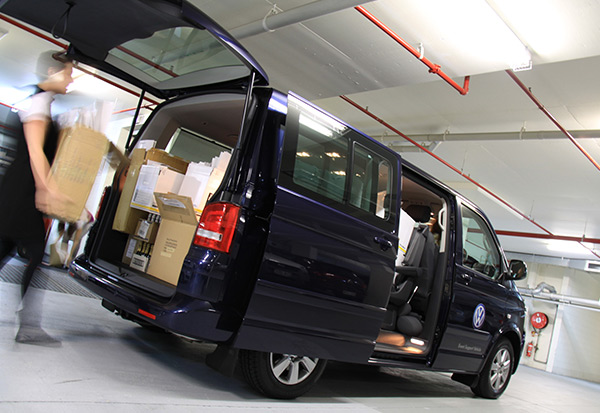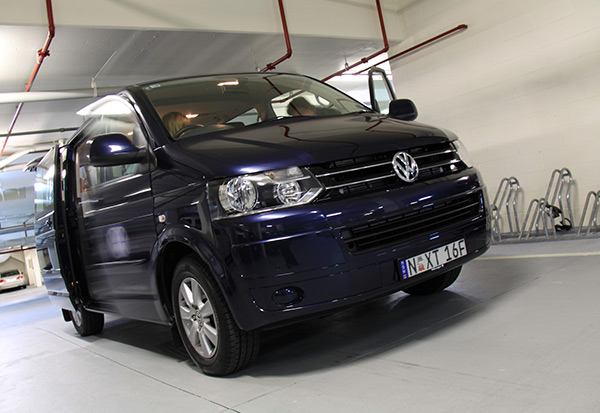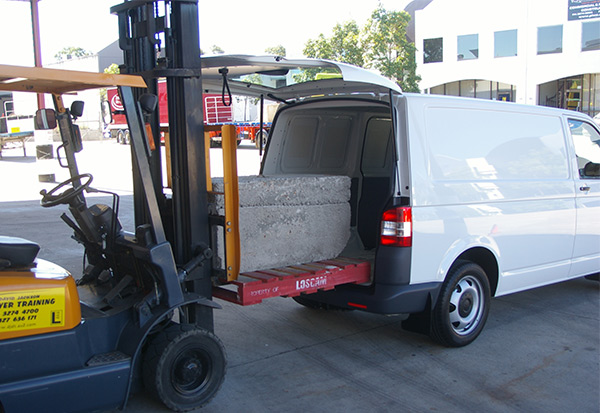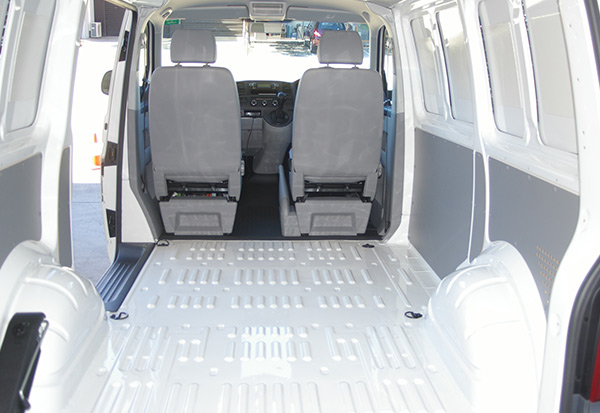With a new Volkswagen Transporter in the dealerships, Gary Worrall put it through its paces, and found it has plenty of pace indeed
The Volkswagen Transporter is one of those vans that seems to have been around forever, or certainly one that seems able to last forever, judging by the number of older models still running on the highways.
Volkswagen Australia unleashed the latest version onto Australian streets in March, offering a boost in power, along with a cleaner burning engine. This move is all part of a strategy to dominate the local light commercial market with a range that covers the Caddy, Transporter, Crafter and the soon-to-be-released-here Amarok.
Having virtually invented the modern delivery van with the original Kombi in the 1950s, Volkswagen has lots of firsthand knowledge to draw on when it comes to designing a new light commercial van, and this experience shows in the latest Transporter.
While the body hasn’t changed much from the previous model, the new Transporter has been revamped with new engines and transmissions and more.
With only minor changes to the styling, the Transporter remains easily recognisable as part of the VW family. The company says while there are no common parts shared between the original model and the latest, the new Transporter is just as robust and reliable as its older cousin.
The new model features the familiar semi-bonneted design that is used by almost all van manufacturers today. By housing the engine in front of the driver the design offers a combination of safety and practicality.
Not only does this allow for crash protection to be engineered into the design, it also means routine servicing becomes much easier, while the driver has a better view of what is in front — much different from the Kombis of old that used a bullbar-mounted spare tyre as the first line of defence.
The angled and curved windscreen assists in aerodynamic efficiency, by reducing the frontal aspect, again, a feature used on virtually all commercial vehicles around the world.
Operators who select the long wheelbase (3,400mm axle to axle) option also get the choice of adding a high roof to the van.
While it ends up looking like an old-fashioned cream van, it offers plenty of extra interior space for large-volume, low-weight cargoes such as toilet rolls or bubble wrap.
The other main body option for the Transporter is the choice of twin sliding doors, one on each side, which improves operational capability by allowing it to be loaded and unloaded from up to three sides at once, a definite plus in the era of one-way city streets and skinny loading docks at shopping centres.
The one real downside to the Transporter is the lack of a barn-door option, as it prevents the use of a forklift to load and unload the van, as the tailgate does not lift high enough to clear the mast.
Despite a massive usable space, even in the ‘standard’ wheelbase model (3,000mm axle to axle), and plenty of room between the wheel arches, our forklift operator could not extend the tines far enough to deposit a pallet in the rear, while the side doors were too narrow for a regulation pallet, although a disposable skid could fit through the opening.
Engine
The Volkswagen Transporter range is powered by 2-litre turbo-diesel engines, in either single or twin turbocharger variants.
The 75kW (100hp) version pumps out 250Nm (185ft-lb) of torque, the 103kW (138hp) model has 340Nm (250ft-lb) of torque and the top-of-the-line 132kW (177hp) variant has 400Nm (295ftlb) at 1,500-2,000rpm.
Transmission
All Transporter models can shift the gears with either a 6-speed manual or 7-speed DSG transmission.
Cab and Controls
While the major architecture remains untouched Volkswagen has taken advantage of the latest developments in electronics to update the T5 Transporter, adding a range of safety and convenience-enhancing equipment.
Among the new offerings is ‘Side Assist’, which uses side-mounted radar to detect if there is a vehicle in the blind spot, triggering an LED at the base of the mirror to warn the driver, although the system only becomes active above 30km/h.
Also offered in this model is a turning light, a driving light that shines at 35 degrees to the side, which turns on with the indicators to allow the driver to see if there any obstacles.
As with the ‘Side Assist’, this system is speed dependent, turning off when the speed rises above 40km/h, while it will only function if the lights are switched on, regardless of the speed.
Other equipment includes a reversing camera, linked to the display screen on the audio unit, allowing the driver to see what is behind the van while reversing, as well as a ‘light and sight’ system that turns the headlights on when the doors are unlocked, or allows them to remain on when the ignition is switched off.
The system is part of the ‘auto’ headlight function, which includes a rain sensor, auto-dimming mirror and dusk-sensing headlights.
The other major upgrade is the fitment of enhanced ESP as standard in all Transporter models, which includes ABS, EBD and traction-control functions, as well as ‘smarter’ deployment of the braking systems to prevent rollovers. The EBD also detects whether the vehicle is loaded or empty and adjusts the traction control to suit.
While the seating position remains the same, with a high-mounted driver’s seat offering an excellent field of view through the windscreen as well as the door mirrors, the seats offer more support than ever, with particularly good support for the driver’s legs, helping to reduce driver fatigue.
There has also been improvements to the air-conditioning system. The controls are now simpler, the driver can choose a temperature and then only have to adjust fan speed and air direction.
The audio system has similarly been overhauled, with touch-screen controls now standard for the navigation system to make it easier to use, while all CD players are able to play MP3-format discs.
The gearshift mechanism remains dash-mounted, although operators have the choice of either a six-speed manual or a seven-speed DSG automated-manual transmission.
Although it creates an odd visual, the dash-mounted gearshift has plenty of ergonomic benefits, with the shifter in easy reach of the driver, as well as creating a ‘walk-through’ between the front seats and the cargo area.
One niggle is the mounting of the handbrake low on the left side of the driver’s seat. Even with my gorilla arms it is a bit of a reach.
Shorter drivers would have a real problem with leaning down to use the lever, because it has to go all the way to the floor to avoid setting off a warning chime.
The dash is easy to read, with big dials for the speedo and tacho, while the electronic dash gets a bar display for the fuel tank, as well as a temperature gauge, plus a combination trip meter and odometer.
VW’s parts standardisation means the Transporter gets the same switchgear as the passenger car range. This means the cruise control is a fiddly switch set on top of the indicator stalk, with an ‘up/down’ button on the end.
Unfortunately, the indicators are quite sensitive and have a habit of turning on if you press too hard on the switch.
Otherwise, the Transporter is a classic example of teutonic efficiency, designed to get the job done, while providing the driver with a reasonable degree of comfort.
Performance
Our test of the Transporter covered both the 132kW (177hp) twin-turbo and the 103kW (138hp) single turbo, both fitted with the seven-speed DSG transmission. Both had plenty of get up and go for the task.
It is difficult to believe the twin-turbo was a diesel; the engine response was rapid, with a flexibility not often seen in an oil-burner.
The tacho needle would race around the dial, especially under heavy acceleration, with the DSG banging through the gears as though the Transporter was a racer in disguise.
Even when it was loaded beyond two tonnes, on a three-tonne GVM, the 400Nm (295ft-lb) engine just pushed the Transporter harder and harder, with no dramas in holding its own in traffic.
Hard as it might be to believe, the engine and transmission are not the highlight.
The true showstopper is the massive disc brakes all round. They really grab your attention, in more ways than one.
With anything other than a full load the brakes packed a punch, pulling the Transporter to a dead stop in distances that are almost beyond the laws of physics.
Be grateful for the three-point inertia reel seatbelts, which are the only things stopping the occupants from becoming one with the windscreen.
The steering is slightly heavy, but is very direct, which Volkswagen attributes to a revised variable-assistance power steering pump.
Despite being a commercial vehicle there is no dead spot around the straight ahead position; it is quick to react to even small inputs on the wheel.
With a 3,000mm wheelbase, it is important to remember just how much van is behind you, especially when it is as reactive as this one, otherwise fleet managers could find themselves replacing a lot of left rear quarters as drivers clip posts and poles because they are not used to the excellent turn-in characteristics.
As expected, the ride is also quite firm.
VW has gone heavy-duty on the suspension to cope with a full load in the back. Yet even when running light it still feels tied down and secure, unlike some other commercials that become nervous or skittish when unloaded.
Verdict
As the owner of a big van, although mine carries human cargo, rather than boxes and crates, I appreciate the effort VW has put into the latest version of the Transporter.
Despite a few small niggles, like the poorly positioned driver’s footrest under the console, and the big step up into the cab, it is a tremendous ‘last-mile’ delivery vehicle; light enough to beat most load limits, but big enough to take plenty of cargo, with enough power to get the job done in short order.
Even in stripped-down delivery van form there are high levels of active and passive safety. The Euro 5-compliant powertrain is not just economical but delivers plenty of pep.
The Transporter has earned a place on a fleet manager’s shopping list.
Likes:
- Flexible power delivery
- Seven-speed DSG
- Brakes
- Huge cargo area
Dislikes:
- Poorly located driver’s footrest
- Fiddly switch for cruise control
- No barn-door option
Specifications
Vehicle: Volkswagen Transporter T5 two-seat van
Engine: 2-litre turbo-diesel, with common rail direct injection, single or twin turbochargers, intercooler standard
Transmission: 6-speed manual or 7-speed DSG
Power/Torque: 75kw (100hp) @ 3,500rpm/250Nm (185ft-lb); 103kW (138hp) @ 3,500rpm/340Nm (250ft-lb); 132kW (177hp) @ 4,000rpm/400Nm (295ftlb) @ 1,500-2,000rpm
Emission Control: Euro 5 with diesel particulate filter
GVM/GCM: 3,000kg/5,000kg
Wheelbase: 3,000mm; optional 3,400mm
Features: Standard climate control air-conditioning; all-wheel discs brakes with ESP, ABS, ASR, MSR, EDL and hill holder, AM/FM/CD stereo, Bluetoooth compatibility, walk-through cab






